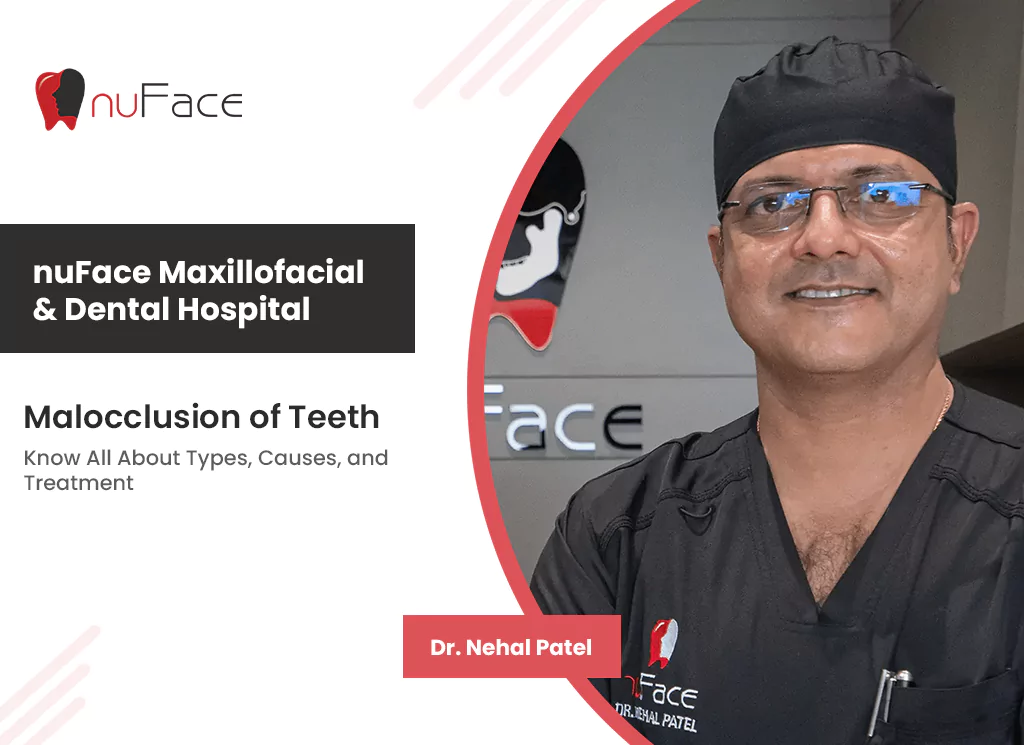Know All About Types, Causes, and Treatment
Malocclusion, commonly known as a misalignment of the teeth or jaw, is a dental condition that affects both appearance and function.
Proper alignment of the teeth is crucial for not only aesthetics but also for ensuring optimal chewing, speaking, and overall oral health.
At NuFace Maxillofacial and Dental Hospital, led by Dr. Nehal Patel, the team specializes in diagnosing and treating malocclusion through state-of-the-art oral and maxillofacial procedures, helping patients achieve healthier and more symmetrical smiles.
What is Malocclusion?
Types of Malocclusion
Class I Malocclusion:
This is the most common form of malocclusion where the bite is normal, but there is minor crowding or spacing between the teeth.
The upper teeth slightly overlap the lower teeth, but the alignment issues can cause discomfort or aesthetic concerns.
Class II Malocclusion (Overbite):
In this type, the upper jaw and teeth significantly overlap the lower jaw and teeth.
It can result in the appearance of a receding chin or protruding upper front teeth.
Patients with a Class II malocclusion may have trouble closing their lips properly and can be prone to speech difficulties.
Class III Malocclusion (Underbite):
Here, the lower jaw protrudes beyond the upper jaw, causing the lower teeth to sit in front of the upper teeth when biting.
This condition can lead to functional problems, such as difficulty chewing and speaking, and also impacts the facial profile, making the chin appear more prominent.
Causes of Malocclusion
Several factors contribute to the development of malocclusion. These include:
Genetics:
Malocclusion is often inherited, meaning if one or both parents have alignment issues, it’s likely that their children will too.
This includes inherited traits like overcrowded teeth, abnormal jaw size, or misaligned bites.
Early Childhood Habits:
Certain habits during childhood, such as thumb-sucking, prolonged bottle-feeding, or pacifier use, can contribute to malocclusion.
These habits can push the teeth out of alignment, particularly during critical periods of jaw and tooth development.
Trauma or Injury:
Injuries to the mouth or jaw can result in improper healing, leading to misalignment of the teeth or jaw.
Such injuries might cause teeth to shift out of place, resulting in malocclusion.
Abnormal Tooth Eruption:
In some cases, adult teeth do not erupt properly, either because they are overcrowded or there is an obstruction.
This can cause teeth to grow crooked, misaligned, or out of place, leading to malocclusion.
Dental Conditions and Poor Oral Health:
Certain dental conditions, such as an improperly fitted crown or dental filling, can lead to misalignment.
Poor oral hygiene and untreated cavities can also contribute to tooth loss, which may affect how the remaining teeth align.
Why Correcting Malocclusion is Important?
Untreated malocclusion can lead to a variety of issues, both functional and aesthetic.
Some of the most common problems include:
Difficulty Chewing and Speaking:
Jaw Pain and TMJ Disorders:
Increased Risk of Tooth Decay and Gum Disease:
Worn or Damaged Teeth:
Treatment Options for Malocclusion
At NuFace Maxillofacial and Dental Hospital, Dr. Nehal Patel and his team provide comprehensive treatment options to address various forms of malocclusion.
The treatment plan depends on the severity and type of misalignment.
Braces and Orthodontic Appliances:
The most common treatment for malocclusion is orthodontic braces.
Braces gradually shift teeth into their correct positions using brackets, wires, and rubber bands.
There are several types of braces available today, including traditional metal braces, ceramic braces, and clear aligners like Invisalign.
Jaw Surgery (Orthognathic Surgery):
For severe malocclusion cases where the jaw alignment is significantly impacted, orthognathic surgery may be required.
This surgery corrects misalignment by repositioning the jaws and can provide dramatic improvements in both function and appearance.
Tooth Extraction:
In some cases, overcrowded teeth may require extraction to create more space for the remaining teeth to align properly.
This is usually performed before braces are applied.
Retainers and Aligners:
Once the teeth are properly aligned, retainers are often used to maintain the results.
Aligners, such as Invisalign, can also be used for less severe cases of malocclusion or as a follow-up treatment after braces.
Social Media Insights and Community Engagement
NuFace Maxillofacial and Dental Hospitalactively engages with its community via social media platforms like Instagram and Facebook.
Dr. Nehal Patelfrequently shares before-and-after results of malocclusion treatments, highlighting the transformative effects of corrective surgery and orthodontics.
This engagement not only provides educational content but also reassures potential patients about the effectiveness of these treatments.
For instance, a recent YouTube video posted by Dr. Nehal Patelon his YouTube channelshowcased a patient’s journey through orthodontic treatment for Class II malocclusion.
The video explained the steps involved and the benefits of early treatment for long-term oral health.
Malocclusion of teeth is a common condition that, if left untreated, can lead to a range of health and aesthetic issues.
At NuFace Maxillofacial and Dental Hospital, Dr. Nehal Patel’s team offers expert care, utilizing cutting-edge technology and treatment plans tailored to each patient’s needs.
Whether through orthodontics or surgical intervention, the goal is to restore function, improve aesthetics, and boost overall oral health.
For more information, visit the NuFace Maxillofacial Services page or schedule a consultation to learn more about treatment options for malocclusion.






